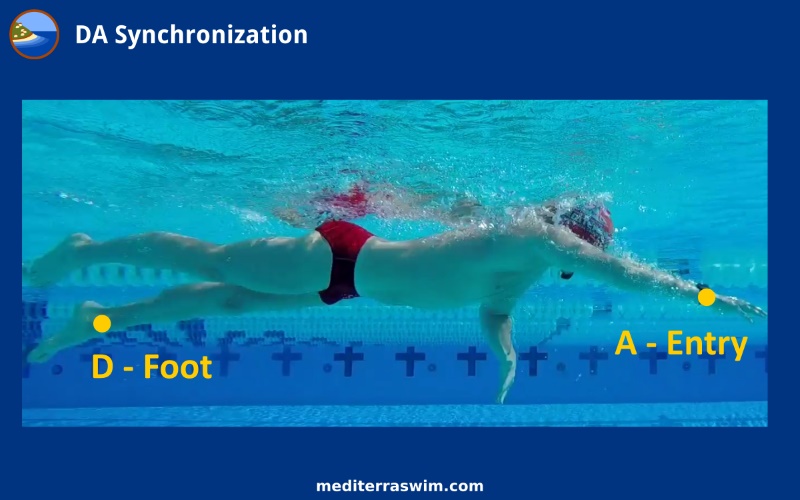Forums › Library › Swim Course Instructions › DA Synchronization Intro
Please type your comments directly in the reply box - DO NOT copy/paste text from somewhere else into the reply boxes - this will also copy the code behind your copied text and publish that with your reply, making it impossible to read. Our apology for the inconvenience, but we don't see a convenient way of fixing this yet.
Tagged: 2 beat kick, entry, extension, kick, propulsion, synchronization
-
AuthorPosts
-
January 1, 2018 at 22:09 #16663
Admin Mediterra
Keymaster
Once you have practiced the DC (foot-hip) synchronization, and the AC (entry/extension-hip) synchronization, then it is just a blending of both of those to create the DA synchronization. However, this is moving across the body, from one extreme end to the other. It can be the most difficult connection to make, but once you do, it is the most pleasing one!
Once again, you are ‘zooming out’ to take in the full body, from foot on one side to wrist on the other, to feel the connection between these two actions, through the torso. The torso rotation empowers the entry and extension to the target. The press of the foot supports the torso rotation. Therefore, the press of the foot helps empower the extension forward.
This is often the last sync combination to practice because the other synchronization combinations are set up to support this main action of extending farther forward on each stroke. This DA synchronization is what will make your stroke as long as it can be optimally. It is what creates the acceleration you seek on every stroke. So, take the time to establish the other connections, and they will enhance this one.
Instructions

Notice how the foot is coming down to its finish position as the entry arm is sliding into Skate Position.
Just as you practiced pressing the foot more slowly, with a steady pressure to match the torso rotation, aim to match the pressure and rate of speed of the extension also. As noted previously, it is tempting to ‘snap’ the foot for an abrupt kick, but this sends a wave of force too quickly forward, before the extending arm is ready to absorb and apply it to extend further. Keep the press of the foot as steady and smooth, matched to the torso rotation, and thereby matched to the entry/extension. The more closely these two are matched and kept proportional in speed, the more the press of the foot can assist that extension, the more you can feel it assisting. The foot will move faster and get to its finish position before the extension finishes, but aim to make that press last longer.
There is some room to adjust the timing of the kick to the tempo. At slower tempos, have the press of the foot come about half way into the entry, with the intent to use the kick to help finish the extension to the target. At very fast (sprinting) tempos, it may be more helpful to have the press of the foot come right as the hand is entering in order to drive it more powerfully and more quickly to the target, since the fast tempo allows so little time to get there through the water resistance ahead.
Remember to keep all actions smooth no matter how much force is involved. You can be powerful, but in water, power must be applied smoothly, gradually building up, in order to create a more uniform (less turbulent) displacement of water molecules. Smooth actions keep drag to a minimum. As Coach Mat says sometimes, “Make the action like you are cutting butter, not like pounding meat.”
And, when you are feeling fatigued, or still have a long way to swim, this can be one of the more endurance-promoting focal points you can use. The default land-mammal reaction to fatigue is to start pulling back harder on the water. Resist this urge. Instead, put your dwindling resources into protecting this Send-Force-Forward emphasis in your stroke. Under fatigue, it will do more to reduce your loss of speed and extend your energy than just about any other emphasis.
-
AuthorPosts
- You must be logged in to reply to this topic.
